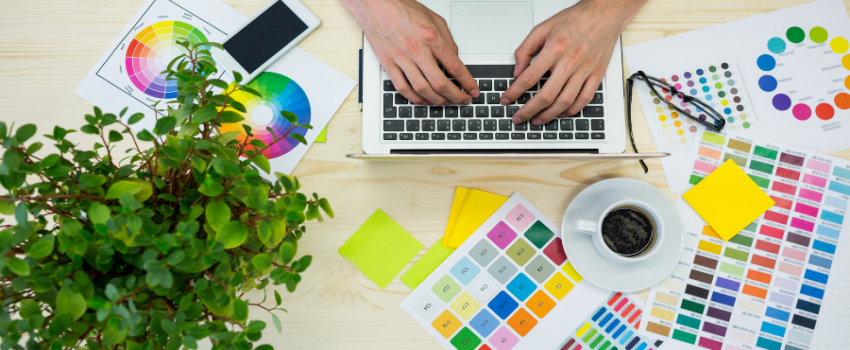The Art of Color in Web Design: Psychology and Effective Use

Color plays a significant role in web design, going beyond mere aesthetics. It is a powerful tool that can evoke emotions, convey messages, and influence user behavior. Understanding the principles of color theory, color psychology, and user experience design is crucial for creating visually appealing and engaging websites. This article will explore the role of color in web design and how it can impact the overall user experience (UX).
Color theory forms the foundation of effective web design color choices. It involves understanding the colour wheel, color harmonies, and the psychological effects of different hues. By strategically selecting and combining colors, designers can create visually balanced and harmonious web layouts that enhance the overall user experience. For example, warm colors like red and orange can evoke a sense of energy and excitement, while cool colors like blue and green can create a calming and serene atmosphere.
Understanding the Psychology of Colors and Its Role in Web Design
In the world of web design, colors hold immense power and have the ability to evoke specific emotions and reactions from users. The psychology behind colors plays a crucial role in the success of a website, as it influences user engagement, perception, and overall experience. By delving into the psychology of colors and incorporating this knowledge into web design, designers can create visually appealing and impactful websites that resonate with their target audience.
The color wheel theory forms the basis for understanding the psychological impact of colors. Different colors elicit unique emotions and associations due to their placement on the color wheel. Warm colors, such as red, orange, and yellow, are known to evoke feelings of energy, passion, and optimism. These colors can be effectively utilized to grab attention and create a sense of excitement on a website. On the other hand, cool colors like blue, green, and purple are associated with calmness, trust, and serenity. These colors are often used in web design to promote relaxation and establish a sense of professionalism and reliability.
Creating a Color Palette That Communicates Your Brand Message
When designing a website, choosing the right color palette is essential for effectively communicating your brand message and creating a visually cohesive experience. The colors you select play a significant role in shaping the perception and identity of your brand. By following certain rules and guidelines, you can create a color palette that harmoniously blends with your brand and resonates with your target audience.
To begin creating a color palette for your website, it's important to start with your brand's existing colors or develop new ones that align with your brand identity. Consider your brand's values, personality, and target market. Are you aiming for a bold and vibrant image or a more calm and sophisticated feel? Understanding your brand's essence will help guide your color choices.
Tips & Techniques to Incorporate Colors Effectively into Your Website
Choosing the right colors for your website is crucial for creating a visually appealing and engaging user experience. Here are some tips and tricks to help you effectively incorporate colors into your website design:
Understand your brand and target audience: Start by considering your brand's personality, values, and target audience. Colors should align with your brand identity and resonate with your intended users.
Research color psychology: Familiarize yourself with the psychology behind colors and the emotions they evoke. For example, blue is often associated with trust and calmness, while red can evoke a sense of urgency or excitement. Choose colors that align with the desired user experience and emotions you want to evoke.
Keep it simple: Avoid overwhelming your website with too many colors. Stick to a limited color palette that compliments your brand and enhances the overall aesthetic. A clean and cohesive color scheme helps users focus on important elements and improves readability.
Create contrast: Ensure sufficient contrast between text and background colors to enhance readability. High contrast improves accessibility and accommodates users with visual impairments. Use color contrast checkers to verify that your color combinations meet accessibility standards.
Use color hierarchy: Establish a visual hierarchy by assigning different colors to different levels of importance. Use bolder or brighter colors for primary call-to-action buttons or important information, guiding users' attention to key elements.
Consider cultural associations: Be mindful of cultural interpretations of colors. Different cultures may
How Different Colors Can Impact User Engagement?
The choice of colors in web design can have a significant impact on user engagement and overall user experience. Different colors evoke distinct emotions and reactions, influencing how users interact with a website. Understanding the impact of different colors on user engagement is essential for creating effective user experiences. Here are some best practices in user experience design when it comes to color selection:
Consider the meaning behind colors: Colors have symbolic meanings and associations. For example, green is often associated with nature and tranquility, while red can evoke a sense of urgency or passion. Understanding these associations allows designers to select colors that align with the message they want to convey and the desired user response.
Use contrasting colors: High contrast between background and foreground colors improves readability and accessibility. Ensure that text is easily legible against the chosen background color. Contrasting colors also help draw attention to important elements, such as buttons or links, leading to increased user engagement.
Leverage color hierarchy: Assign different colors to different levels of importance within the design. By using a limited color palette and reserving brighter or bolder colors for crucial elements, designers can create a visual hierarchy that guides users' attention and encourages interaction with the most important parts of the website.
Test and iterate: Conduct usability testing and gather feedback to evaluate the impact of colors on user engagement. A/B testing different color variations can provide valuable insights into which combinations and shades resonate better with your target audience. Continuously refine your color choices based on user feedback to optimize engagement rates.
Consider cultural context: Different cultures have varying interpretations and associations with colors. When designing for a global audience, it is important to be aware of these cultural differences and avoid inadvertently conveying unintended messages or causing offense. Conduct research or consult with experts to ensure your color choices align with the cultural context of your target users.
Conclusion: In conclusion color plays a crucial role in web design, impacting user experience in profound ways. By understanding color theory, psychology, and user experience design principles, designers can harness the power of colors to create visually appealing and engaging websites. The strategic use of colors can evoke specific emotions, guide user attention, and communicate brand messages effectively.











